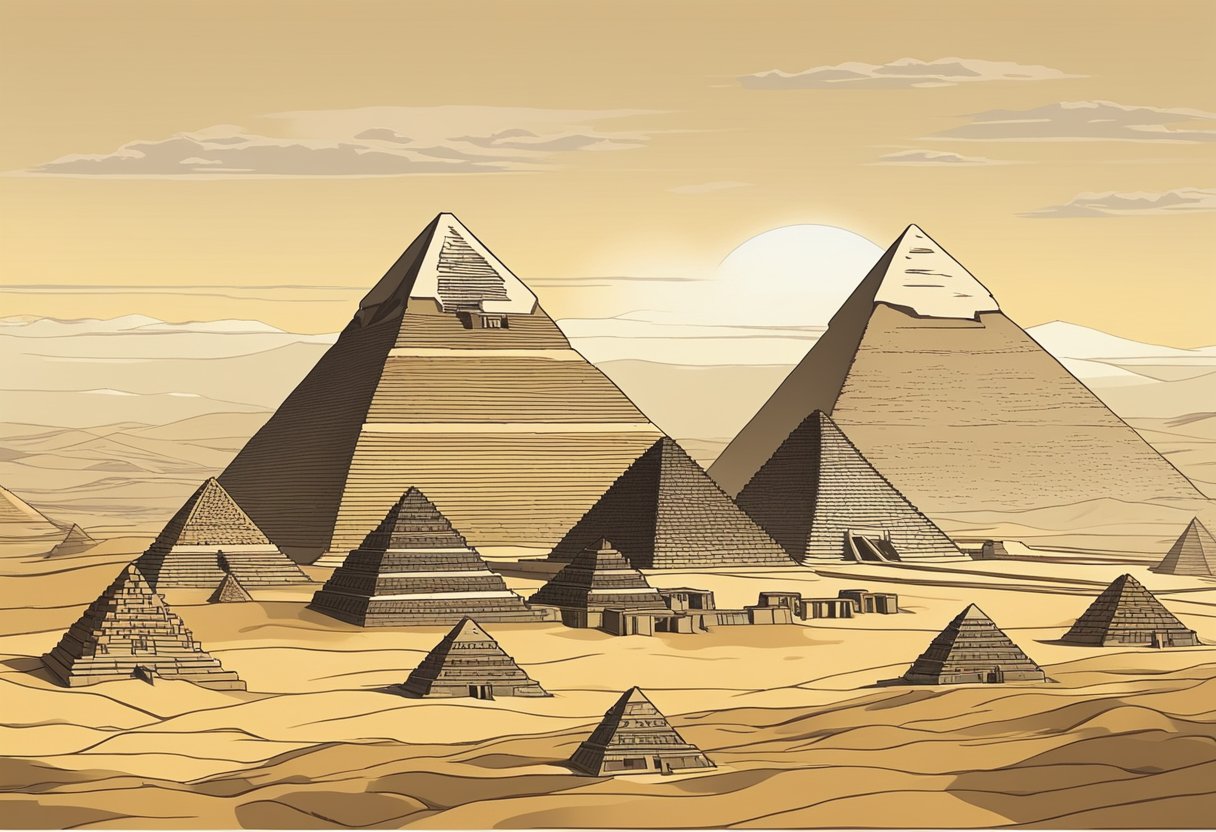How Many Pyramids Are There in the World?
As an enthusiast for ancient architecture and world history, I have come to realize that pyramids stand as some of the most awe-inspiring and enigmatic structures ever constructed by human civilizations. So how many pyramids are there in the world?
These monumental creations are not limited to the sandy reaches of Egypt—a country synonymous with pyramids. In fact, the existence of pyramids spans multiple continents, including Africa, Asia, and the Americas. Countries like Sudan, with its steep Nubian pyramids, and Peru, where the Moche civilization left its truncated pyramids, are testament to the global reach of these historic marvels.

How many pyramids are there in the world?
There are more than 400 pyramids world-wide. The precise number of pyramids in each country is difficult to determine, as new discoveries are constantly being made, especially in remote areas using advanced scanning technologies
| Country | Number of Pyramids (Estimate) | Most Notable |
|---|---|---|
| Belize | 5 | El Castillo (The Castle) at Xunantunich Caana (Sky Palace) at Caracol High Temple at Lamanai |
| Cambodia | A few | Baksei Chamkrong Temple near Angkor Wat |
| China | Around 40 | Mausoleum of the First Qin Emperor |
| Egypt | Over 100 | Pyramids of Giza |
| El Salvador | A few | Pyramids at Tazumal |
| France | 2 | Pyramid of Falicon Pyramid of Couhard |
| Germany | 3 | Karlsruhe Pyramid |
| Greece | 1 | Pyramid of Hellinikon |
| Guatemala | Several | Pyramids at Tikal |
| Honduras | A few | Pyramids at Copán |
| Indonesia | 4+ | Borobudur Temple |
| Iran | 1 | Ziggurat of Chogha Zanbil |
| Iraq | 1 | Ziggurat of Ur |
| Italy | 1 | Pyramid of Cestius in Rome |
| Japan | 4 | Daisen Kofun, |
| Mexico | Around 30 | Pyramid of the Sun Pyramid of the Moon at Teotihuacan |
| Peru | A few | Pyramid of the Sun at Machu Picchu |
| Sudan | 200+ | Meroe Pyramids |
| United Kingdom | 1 | Pyramids of Scotland |
| Total | 400+ |
Global Pyramid Construction
I have discovered that Mexico’s rich history of pyramid construction, underpinned by the Mayan and Aztec civilizations, showcases a different architectural evolution compared to Egypt’s smooth, limestone-sheathed structures.
Elsewhere, the remnants of ancient Rome’s pyramid, the Pyramid of Cestius, demonstrate that the pyramid form appealed even to the classical world. My exploration led me to uncover that regions as diverse as Iraq, Indonesia, and Guatemala also fashioned pyramids, serving various purposes from religious to funerary.
The Universal Significance of Pyramids
While the pyramids of Egypt, with their precise alignment and colossal scale, remain the most emblematic, my research affirms that these mathematical feats are echoed in other lands. The sheer number and variety of pyramids across the globe highlight a fascinating pattern of cultural significance and complexity.
Whether stepped, smooth, or truncated, pyramids draw a line through the story of civilizations from different eras and regions, emphasizing their shared gravitation towards this monumental architectural form.
Pyramids of Egypt

Egyptian pyramids, architectural marvels of ancient construction, primarily represent elaborate tombs of the pharaohs.
Giza’s Grand Complex
The most eminent pyramid complex is found at Giza, near Cairo. Here lies the Great Pyramid of Giza, attributed to Pharaoh Khufu. Standing as the last of the Seven Wonders of the Ancient World, it’s a demonstration of the architectural advancement of the Old Kingdom.
Saqqara and the Step Pyramid
Adjacent to the Great Pyramid are the pyramids of Pharaohs Khafre and Menkaure. Khafre’s complex also boasts the iconic Great Sphinx. The pyramids are predominantly built from limestone and served as a testament to the pharaohs’ absolute power. Saqqara is another significant site, where the Step Pyramid of Djoser stands out as a central feature, designed by Imhotep, the proverbial pyramid pioneer.
Aligning with the Afterlife
The pyramids align along the west bank of the Nile River, apt due to the ancient Egyptian belief in the sun’s cycle and its connection to the afterlife. Traditionally, pyramids evolved from earlier structures known as mastabas and displayed significant advancements over time.
Dahshur’s Innovations
The Red Pyramid and the Bent Pyramid in Dahshur, both attributed to Snefru, reveal the transitional pyramid-building techniques that eventually led to the true smooth-sided pyramids seen at Giza. These structures culminate the evolution of pyramid construction during the 4th Dynasty.
Beyond Tombs – A Complex Society
It’s important to note that the pyramids were part of a larger temple complex, which included various structures such as smaller satellite pyramids, mastabas, and temples, highlighting their role in the religious and ceremonial aspects of ancient Egyptian society.
Legacy of the Egyptian Pyramids
In sum, the Egyptian pyramids, especially the Pyramids of Giza off the Nile, are enduring symbols of Egypt’s legacy, casting long shadows over history and the sands of time.
Pyramids Around the World

When considering the most impressive pyramids, Egypt’s monumental structures often come to mind. However, it’s important to recognize that these ancient wonders aren’t exclusive to Egypt.
Pyramids in Sudan
In fact, Sudan has more pyramids than Egypt, boasting over 200 pyramids built by the Kushite Kingdom during the 25th Dynasty. These Nubian pyramids, smaller and steeper than their Egyptian counterparts, are concentrated around the ancient city of Napata, a former capital of Kush and a UNESCO World Heritage Site.
Pyramids in Mexico
Moving to Mexico, the **Great Pyramid of Cholula ** in Puebla is considered the largest pyramid in volume. Not far away is the awe-inspiring city of Teotihuacan, home to the magnificent Pyramid of the Sun, which is one of the largest in Mesoamerica.
Pyramids in Italy
Across the Atlantic, in Rome, Italy, the Pyramid of Cestius is an intriguing example of Egyptian influence on Roman architecture. This pyramid is an ancient tomb dating back to 12 B.C.
Pyramids in Iraq
The ancient civilization of Mesopotamia (modern-day Iraq), known for its rich contributions to civilization, also constructed pyramidal structures. The ziggurat at Ur is a prime example.
Pyramids in Peru
In Peru, pyramids were central to many pre-Columbian cultures, with noteworthy examples found in the Moche and Caral civilizations.
Pyramids in Guatemala
Guatemala‘s contribution to this discussion features the ruins of Tikal, where the Maya built impressive pyramids, some restored, that endure as a testament to their sophisticated understanding of astronomy and architecture.
Pyramids around the planet continue to reveal new truths, as ongoing restoration projects and archaeological efforts bring more knowledge to light. I find it phenomenal how these ancient structures provide insight into past civilizations across the globe.







